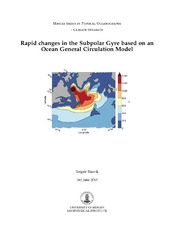Rapid changes in the Subpolar Gyre based on an Ocean General Circulation Model
Master thesis
Permanent lenke
https://hdl.handle.net/1956/6932Utgivelsesdato
2013-06-03Metadata
Vis full innførselSamlinger
- Geophysical Institute [1187]
Sammendrag
Data from the ocean component of the Norwegian Earth System Model has been analyzed for the period 1960-2008. Most attention is given to the Subpolar Gyre, which strength and spatial extensiveness is understood to have major consequences for the marine climate in the North Atlantic. Variations in the ocean temperature and salinity are mainly found in the upper few hundred meters, to a large degree dictated by the atmospheric forcing. The Labrador Sea is the region which shows largest response to the atmospheric forcing, and is a major source for variations in the Atlantic Meridional Ocean Circulation at 41\(^{\circ}\)N. In the Labrador Sea, the convective mixing during strong cooling events reaches down to 2000-2500 m and increases the thickness of the isopycnic layer of potential density 1036.843 kg m\)^{-3}\) (relative to 2000 m depth) by approximately 500 m relative to the climatological mean value. This water mass more than double in volume between a minimum in 1970 and a maximum in 1995. Using an idealised model and Margules relation, we have shown that a 5 Sverdrup (1 Sv \(= 10^6\) m\(^3\) s\(^{-1}\)) intensification of the barotropic streamfunction for strong versus normal years expressed in terms of the North Atlantic Oscillation (NAO) index is consistent with roughly an increase in the geostrophic flow of 15\%. Using composites from a NAO index derived from two-station and spatial pattern-based sea level pressure differences show negligible to large differences in the upper ocean response to the atmospheric forcing, depending on the actual analyzes examined.
